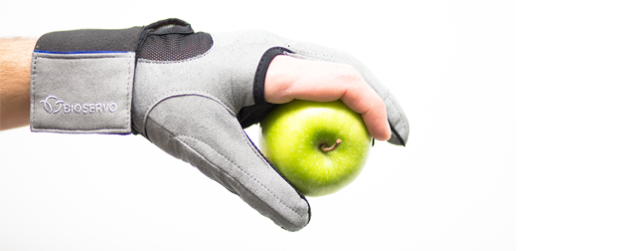According to the American College of Sports Medicine, wearable technologies are the worlds current number one fitness trend (Thompson, 2015, 2016). By providing patients with an instant biofeedback, wearables not only have the possibility to prevent injury and overuse, but also to optimize training (Düking, Holmberg, & Sperlich, 2017) which becomes of special interest in rehabilitation where exercising optimally is paramount for your health. We gathered what applications are there for increasing a patient’s rehabilitation process. The companies introduced below will exhibit at the upcoming WT | Wearable Technologies Show 2017 MEDICA on November 13-16, 2017 in Düsseldorf.
More than 50 million people are estimated in Europe, North America and Japan to suffer from a weak hand due to illness, injury, stroke or old age. The Swedish company Bioservo Technologies aims to give them a helping hand with their SEM Glove™. Thanks to state-of-the-art robotic SEM™ technology they have endless possibilities to support people with a weakened grip to get new strength and endurance in their hands and to prevent strain injuries.
Empowering physiotherapy, Luna EMG by EGZOTech is a multi-functional upper and lower limb rehabilitation robot for neurological and orthopedic patients. It can perform force or EMG driven active movement exercises with severely atrophied patients for example after a stroke, with muscular dystrophy or MS. Luna uses isolating extensions to train single joints or functional and dynamic ones to exercise whole limbs in real life patterns, extensions can be swapped within 10 seconds to quickly move the patient through training sessions and enable a faster recovery time.
Maximum, minimum and average force, jump power, weight distribution and motion are critical parameters in many sports. The FORCIOT Measurement System can be integrated into different sports wearables, for example sports shoes, insoles or gloves. It enables athletes, coaches and physiotherapists to measure performance data in every exercise, anywhere. The system provides objective data for finding a perfect balance of rest and exercise for long-term improvement and for optimizing maximum race performance.
Movement is essential in our lives but can be affected by trauma, aging or disease. How about knowing who is safe or at risk? How about accurately quantifying your moves? Gait Up provides innovative wearable sensors and software for motion analysis in sports and clinics. With their Physilog® applications they are turning motion sensor signals into meaningful data related to performance or disability.
To help people stand up again and walk independently, FREE Bionics has developed FREE Walk, an exoskeleton for people with limited mobility, muscle weekness or paraplegia. With this walking assistive exoskeleton technology that mimics the most natural human gait, users can easily keep balance and transfer their center of mass forward. It has a user-oriented design and adjustments for every new user can be done within five minutes.
A life in motion: Mollii is a neurorehabilitation concept providing individually adapted rehabilitation in the form of a garment with electrotherapy programmed according to each person´s needs. The assistive device can be used in home environment by people with spasticity or other forms of motor disability. It can help to reduce undesired reflexes and stiffness, thus enabling an improved range of motion and functional ability.
Shimmer provides advanced development of wearable sensing systems. Their wearable sensor platform and equipment allows for simple and effective biophysical and kinematic data capture in real-time for a wide range of application areas. Designed to be robust, flexible and configurable, the technology provides high quality scientifically reliable data to support researchers and academics in their data collection.
Another company providing fitness and rehabilitation solutions for sports and wider medical applications is TMG-BMC. They are creating and developing in the field of tensiomyography, an evidence-based method which enables precise measuring of individual muscles’ contraction characteristics – the ability of the muscle to contract or relax. This information is crucial for the identification of injury risk, supports return to play decisions for athletes and shows change in performance over time.
TracPatch by Consensus Orthopedics is here to help enable patients and healthcare providers to strive for exceptional post-surgical outcomes and continuously monitors wound temperature after implant or surgery. Healthcare providers can now engage patients every day during their episode of care. Patients feel empowered to reach their rehabilitation goals. TracPatch connects healthcare providers to what matters most: improving patient lives.
References:
Düking, P., Holmberg, H. C., & Sperlich, B. (2017). Instant Biofeedback Provided by Wearable Sensor Technology Can Help to Optimize Exercise and Prevent Injury and Overuse. Front Physiol, 8, 167. doi: 10.3389/fphys.2017.00167
Thompson, W. (2015). Worldwide survey of fitness trends for 2016: 10th Anniversary Edition. ACSM Health Fitness J, 19, 9-18. doi: 10.1249/FIT.0000000000000164
Thompson, W. (2016). Worldwide Survey Of Fitness Trends For 2017. ACSM Health Fitness J, 20(6), 8-17. doi: 10.1249/FIT.0000000000000252













